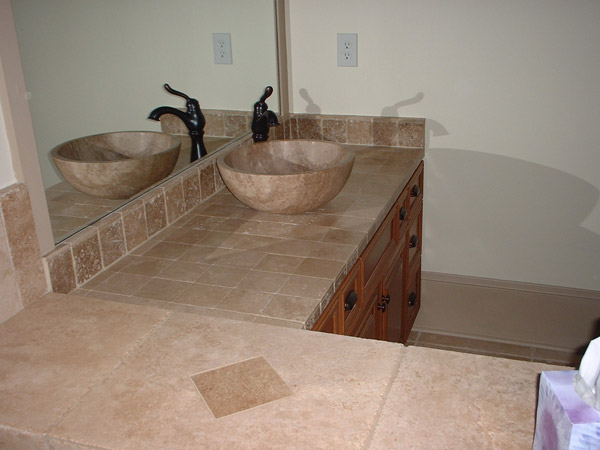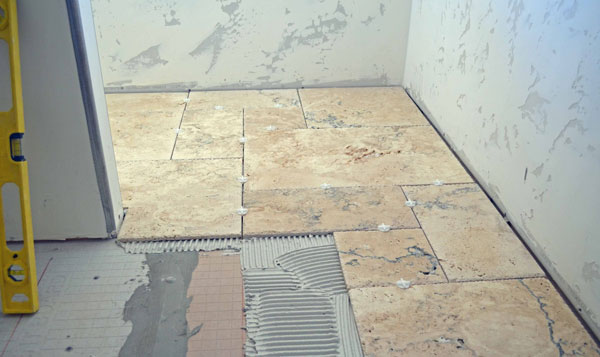In this fast-paced world, there is a wide range of variations in materials when it comes to home décor, be it flooring, wall cladding, interiors or exteriors. These materials are trending in home décor and are competing everyday with each other. Travertine is one of the trendiest materials used in décor. It is a type of limestone which is formed in mineral spring deposits. It is used as a flooring material and is available in solid tile form. It comes in a variety of earthy tones like tans, browns, rust and beige hues. Like the other natural stones, it has specific requirements, and it is not appropriate for all locations. According to ‘James Stevens Curl and Susan Wilson’ (Authors of The Oxford Dictionary of Architecture), “Travertine is an ochre, amber or cream coloured textured limestone (also called marble), pitted with irregular holes, found in Tiber Valley near Rome, and are used since Antiquity for paving, cladding etc.” It is one of the materials which provides a beautiful design.

An installed travertine floor can add a unique blend of beauty to any interior space. It is one of the few types of flooring which works well for interiors as well as exteriors. Like most natural stones, it is installed by professionals. It is very heavy and thick and can be tricky to align the tiles or pavers for a perfectly flush surface. It is a highly durable material which makes a home look very beautiful.
According to W.B.Mckay (Author of Building Construction Metric), “Travertine is an Italian marble which is used for decorative purposes. it consists of hardened masses of carbonate of lime deposited by springs. It has a texture of straw, amber and golden ground with irregular darker graining.”

Travertine is one of the most frequently used stones in modern architecture. It is used on building surfaces, cladding and flooring. It is also used for paving patios and garden paths.
Characteristics of Travertine Tile Flooring
01. Porosity
- One of the retaining characteristics of travertine is its porosity. The pocked surface of travertine stone gives it its unique natural and chaotic texture. But its porosity also represents added maintenance issues which are found with most man-made flooring and even some other types of natural stone. Travertine is a sedimentary rock which is formed by the settling of minerals and organic matter close to the earth’s surface. The travertine stone is laced with holes and pockets created by bubbling carbon dioxide which makes it porous.

02. Textures
- There are many types of travertine tile available depending on its texture which includes polished (smooth and polished resembling marble), honed finish (low shine with matte finish) brushed travertine (rough texture and matte finish), saw cut (matte finish with no colour), tumbled travertine (the most natural textured finish with no shine). In its natural state, travertine is rough-textured. But, polishing it changes its nature, creating a thin layer that makes the stone’s colour pop out, resulting in an overall richer look. A polished travertine floor has a glossy finish which reflects light from the room more than tumbled or brushed travertine.

03. Dry Set Applications
- For exteriors, travertine can be either dry-set or mud-set. Stones should be placed as close as possible. Travertine being one of the softer stones, it can be cut with a circular saw, a diamond blade or a tile saw.

- For dry-set applications, sand is swept between the pavers after they have been set. A new method is to sweep polymeric sand into joints. The polymeric sand is a combination of filtered and size-calibrated sand and polymeric adhesives. When sprayed with water, the adhesives first soften and then they combine with the sand, hardening and binding the sand together.
As any material has its pros and cons, so does travertine!
Listed below are the pros and cons of travertine tiles.
Advantages of Travertine Tile Flooring
Appearance, strength and long-lasting quality are the main strengths of this flooring.
01. Stylish
- This is one of the oldest building materials in existence, and its presence in a flooring installation adds a sense of age and prestige to the environment. Travertine has an inherently dominant energy that draws attention in a subtle, subdued way, with mild tones found in work of earth art, making any floor created from them look divine.

02. Subdued
- Another style of travertine is that it has a unique power of natural stone but also, it maintains the soft palette of colors in its spectrum. Available in tans, beiges, greys and speckled off-white hues, these tiles can bring the towering dominance of earth to a flooring installation without overwhelming a room with dramatic colors.
03. Durability of Travertine Tile Flooring
- Hard tile materials like travertine are made to take stress without showing significant signs of damage from scratches, cracks or chips. Over time, a weathering effect can occur, which is often prized for giving the individual pieces a unique character that evokes ancient architecture. With polished and honed materials, these are at a higher risk of scratches, whereas naturally-finished tiles are more resistant towards damages and blemishes.

- These materials have the potential to last for decades, if kept with regular maintenance and care. The weathering effect that occurs with years of use is often considered as attractive, but it can be prevented with the use of a stone-sealing agent.
04. Ease of Repair
- Since, travertine comes in tile form that when a piece of travertine breaks, it can be easily removed and replaced. If you are installing a new floor, be sure to keep a few extra tiles so that it can be replaced, hence making it a perfectly colored match for the floors.
Disadvantages of Travertine Tile Flooring
Travertine’s durability doesn’t make it necessarily low-maintenance. It is more difficult to install than any other types of flooring.
01. Complicated Maintenance
- While these tiles are reliable, strong, and durable, they also have very microscopic pores in their surface that allows spilt liquids and staining agents to penetrate the material. This problem is resolved by applying sealer, followed by a barrier surface sealer. This dual-sealing treatment is used during installation and then periodically throughout the life of the floor. Re-sealing should be done more often if one wants to maintain the original glossy finish of the material.
02. Heaviness
- Travertine tiles are quite heavy, making the installation difficult and time-consuming. It is best to leave the setup to professionals. The weight of the flooring is also a concern with regard to the floor structure, which has to be strong enough to support the flooring without excessive bowing or flexing.

03. Expensive
- Travertine can be costly; it falls under the range of natural stone options but on the higher end of the types of flooring materials. Besides, there are costs for installation materials including adhesive and grout as well as professional labor.

04. Coldness
- Like most of the solid-stone elements, travertine flooring can retain heat and cold as well. The floor can be uncomfortably cold if walked on it barefoot in the early winter mornings. Once the travertine floor tile heats up, it is an excellent conductor of heat to warm up the room.

How to Install Travertine Tile Floor?
01. Measure
- Measure the room’s dimension to determine the area of the room. Then add 10% to the area for wastage.
02. Layout
- With Using a measuring tape, determine the center of the room and mark lines on both the sides with chalk. When you start laying the tile, begin from the corner where the chalk lines meet. This allows to create a professional look. Spend a good amount of time planning and laying out the travertine tiles in the pattern you want.
03. Lay the Tile
- Start laying the first tile in the corner of the intersection of chalk lines made initially. Use trowel to apply thin set (adhesive mortar) on the floor. Make sure that the thin set is spread evenly. Place one tile in the thin set and press down on the tile. Place tile spacers on all the corners of the tile. Now, place another tile in the thin set directly up against the tile spacers from the first tile. Put the tile spacers around the new tile and continue laying in the same way.

04. Cutting the Travertine
- When you get out of the room, you will need to cut the tile. Use the tape for proper dimension of the tile to be cut. Then place the tile on the wet saw and make an appropriate cut. Place the cut piece of tile in the gap on the floor.
05. Grout
- Allow the tile adhesive to dry for 24 hours. Apply grout float to the joints of the tile. Make sure that there are no gaps in grout.
06. Clean
- Wet a sponge to wipe the tile to eliminate extra grout on the top of the tile. This will make the grout smooth.
To put it all together, the travertine floor adds a unique touch to your interiors. It is one of the trendiest floor materials i.e. used nowadays as décor. The characteristics including porosity, high durability, ease of repair which makes it available to use Travertine as flooring material for homes. It is a highly durable flooring material which adds up to the natural aesthetic beauty of your homes.
Also Read:
Things to Keep in mind while doing Tiling Work at Home!
Warning: These 9 Tiles Defect may Destroy the Beauty of Your House!
Causes of Cracked Tile in Your House
Image Courtesy: Image 2, Image 3 – vridema, Image 6, Image 11

